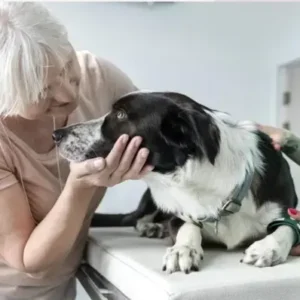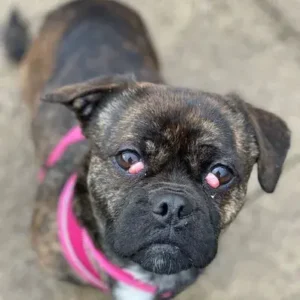Grades of Patellar Luxation
The severity of patellar luxation is classified into four grades, ranging from mild to severe. Understanding these grades of patellar luxation helps in determining the appropriate treatment and management options.
- Grade 1: The patella can be manually moved out of place but returns to its normal position. Dogs may not show visible signs of discomfort, and the condition is often detected during routine veterinary exams.
- Grade 2: The patella occasionally luxates (dislocates) due to movement or manual pressure, but can return to its normal position. Dogs with this grade may show mild lameness or occasional skipping while walking.
- Grade 3: The patella is frequently out of place and may require manual adjustment to return to its normal position. Affected dogs often have persistent lameness and difficulty bearing weight on the affected leg.
- Grade 4: The most severe form, where the patella is permanently dislocated and cannot be manually repositioned. Dogs with Grade 4 patellar luxation often experience severe mobility issues, joint pain, and abnormal limb posture. Surgical intervention is typically required to restore function and alleviate discomfort.
Early detection and proper management based on the grades of patellar luxation can help improve a dog’s quality of life and prevent further joint damage.
Causes and Risk Factors
Several factors contribute to patellar luxation in dogs. Understanding these causes can help dog owners take preventive measures and manage the condition effectively.
- Genetics: Some dogs are naturally at a higher risk of patellar luxation due to their genetic makeup. This condition is more common in smaller dogs, where the kneecap tends to dislocate inward, a condition known as medial patellar luxation (MPL).
- Trauma or Injury: A sudden impact, such as a fall, accident, or rough landing, can knock the kneecap out of place. This is especially common in active dogs that jump frequently or engage in high-impact activities like agility training.
- Breed Predisposition: While smaller dogs are more frequently affected, large breed dogs can also develop patellar luxation. In these cases, the kneecap may dislocate outward, a condition known as lateral patella luxation (LPL). This is often linked to structural issues like hip dysplasia, poor limb alignment, or joint instability.
- Obesity and Poor Nutrition: Excess weight places added strain on the joints, making patellar luxation worse. Overweight dogs are more likely to experience knee instability due to weakened ligaments and increased pressure on the joints. Poor nutrition—especially a lack of calcium, phosphorus, and vitamin D—can also weaken thigh bones.
How to Reduce the Risk
- Maintain a Healthy Weight – Prevent excess strain on joints.
- Provide a Balanced Diet – Ensure proper nutrients for thigh muscle and joint health.
- Avoid High-Impact Activities – Reduce stress on the knees, especially in prone breeds.
- Schedule Regular Vet Checkups – Early detection can prevent severe cases.
By understanding these risk factors and taking proactive steps, dog owners can help keep their pets active and comfortable for years to come.
Symptoms of Patellar Luxation
Recognizing the early signs of patellar luxation is crucial for timely treatment and preventing the common condition from worsening. Dogs may not show symptoms in the early stages, but as the condition progresses, certain behavioral and physical signs become more noticeable.
- Intermittent Lameness – Dogs may limp occasionally or favor one leg, especially after exercise.
- “Skipping” Gait – Affected dogs may lift their leg briefly while walking or running, then resume normal movement.
- Difficulty Standing or Jumping – Hesitation when jumping onto furniture or climbing stairs can indicate knee discomfort.
- Sudden Yelping or Discomfort – A dog may cry out in pain when the patella shifts out of place.
- Stiffness or Reduced Activity – Dogs may become less active due to discomfort, avoiding play or long walks.
- Visible Knee Dislocation – In severe cases, the kneecap may appear out of place, and the leg may look misaligned.
If you notice any of these signs, consulting a veterinarian as soon as possible is essential. Early diagnosis and proper management can help slow the progression and improve your dog’s quality of life.
Commonly Affected Breeds
Certain dog breeds are more likely to develop patellar luxation, particularly small breeds due to their physical structure, though larger breeds can also be affected.
| Small-Breed Dogs | Large-Breed Dogs |
| Affenpinscher | Akita |
| American Water Spaniel | Chinese Shar-Pei |
| Boston Terrier | Flat-Coated Retriever |
| Brussels Griffon | Great Dane |
| Chihuahua | Great Pyrenees |
| English Toy Spaniel | Irish Wolfhound |
| Lancashire Heeler | Newfoundland |
| Maltese | Saint Bernard |
| Pekingese | |
| Pug | |
| Shih Tzu | |
| Smooth-Haired Fox Terrier | |
| Yorkshire Terrier |
Diagnosing Patellar Luxation
If you notice any of these symptoms, consult a veterinarian for a thorough evaluation. The diagnosis typically involves:
- Physical Examination: The vet will manually assess knee stability by manipulating the joint.
- X-rays or Imaging: Helps determine the severity and rule out other joint conditions.
- Gait Analysis: Observing how the dog walks and moves can provide insights into the condition.
Treatment Options
In severe cases of patellar luxation, the kneecap may become permanently luxated, requiring surgery to restore proper joint function. For dogs with Grade 3 or 4 luxation, where the condition is more advanced, surgery becomes essential to realign and stabilize the knee.
Non-Surgical Treatments (For mild cases)
- Weight Management: Keeping your dog at a healthy weight reduces strain on the joints.
- Physical Therapy: Strengthening the muscles around the knee helps provide better joint support.
- Joint Supplements: Glucosamine, chondroitin, and omega-3 fatty acids can promote joint health.
- Pain Management: Anti-inflammatory medications may be prescribed to alleviate discomfort.
Surgical Treatments (For moderate to severe cases)
Surgery is recommended for dogs with Grade 3 or 4 patellar luxation. The most common procedures include:
- Tibial Tuberosity Transposition (TTT): Adjusts the alignment of the knee joint.
- Trochlear Block Recession: Deepens the groove in the femur to hold the kneecap in place.
- Soft Tissue Reconstruction: Reinforces surrounding cruciate ligaments to stabilize the patella.
Post-surgery, rehabilitation, and controlled exercise are essential for a successful recovery.
Prevention and Long-Term Management
While patellar luxation may not always be preventable, dog owners can take steps to reduce the risk:
- Regular Exercise: Strengthening quadriceps muscles around the knee provides better joint stability.
- Maintain a Healthy Weight: Avoid excessive weight gain to minimize stress on the joints.
- Provide Supportive Flooring: Non-slip surfaces can prevent accidental falls and injuries.
- Routine Veterinary Checkups: Early detection and intervention can prevent progression to severe grades.
Prognosis: Can Dogs Live a Normal Life?
With proper treatment and care, dogs with patellar luxation can lead happy and active lives. Mild cases often require minimal management, while surgical cases have a high success rate with appropriate rehabilitation.








